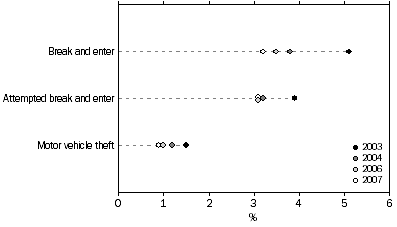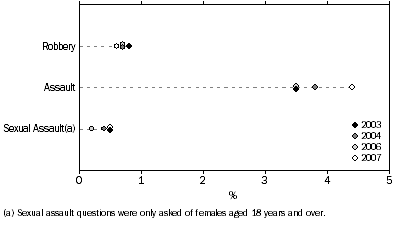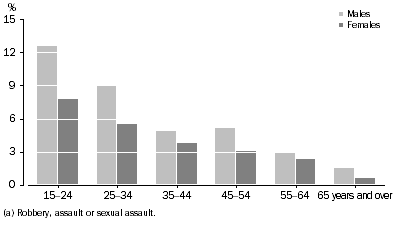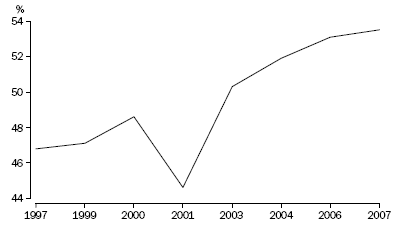SUMMARY OF FINDINGS
HOUSEHOLD CRIME
A total of 172,700 households (6.5% of all households in NSW) were victims of household crime in the 12 months to April 2007, which was similar to the 2006 and 2004 victimisation rates (6.8% and 7.4% respectively). These rates were lower than the 2003 figure, which was 9.4%
The victimisation rates for break and enter (3.2%), attempted break and enter (3.1%) and motor vehicle theft (0.9%) also remained similar to their corresponding 2006 and 2004 rates.
VICTIMISATION RATES FOR HOUSEHOLD CRIME — 2003 to 2007

As in 2006, the household victimisation rate for Sydney in 2007 (6.7%) was about the same as for the balance of NSW (6.1%).
In 2007, there was no significant difference between household victimisation rates for different household types.
PERSONAL CRIME
There were 272,500 usual residents aged 15 years and over in NSW who were victims of personal crime in the 12 months to April 2007, a victimisation rate of 5.0%. This has increased from 2006 (4.2%) but does not significantly differ from 2004 (4.5%).
Assault was the only type of personal crime to show a statistically significant increase from 2006. The victimisation rate for assault was 4.4% in 2007, an increase from 3.5% in 2006 and 3.8% in 2004. The victimisation rate for robbery in 2007 (0.6%) was unchanged from the 2006 figure (0.7%). The apparent increase in sexual assault victimisation rates between 2007 (0.5%) and 2006 (0.2%) was not statiscally significant.
VICTIMISATION RATES FOR PERSONAL CRIME — 2003 to 2007

As with household crime, the personal crime victimisation rate for Sydney (4.9%) was similar to that for the balance of NSW (5.2%). However, the victimisation rate for Sydney in 2007 (4.9%) had increased from the 2006 figure (4.0%). The rate for the balance of NSW in 2007 (5.2%) was similar to the 2006 figure (4.6%).
Persons not in the labour force had a lower victimisation rate (3.1%) than both employed persons (5.8%) and unemployed persons (8.9%). The apparent difference between victimisation rates for employed persons and unemployed persons was not statistically significant.
Overall, males were more likely to have been victims of personal crime than females. There were 166,300 male victims, a victimisation rate of 6.2%, and 106,200 female victims, a victimisation rate of 3.9%. The differences between the victimisation rates for males and females were significant for 15-24 year olds and 25-34 year olds. The differences between the sexes for all other age groupings were not statistically significant.
Victimisation rates showed a general decline with increasing age. The differences in victimisation rate between adjacent age groups were significant for all age groupings except between 35–44 year olds and 45–54 year olds.
VICTIMS OF PERSONAL CRIME(a), Age and sex — 2007

Of the 241,400 victims of assault, about half (49%) knew their offender in the most recent assault. Of the victims who knew their offender, around one in five (21%) stated that the offender was a family member.
Assaults most commonly occurred in the street or other open land (24%); at the victim's place of work or study (23%); or at the victims home (20%).
MULTIPLE INCIDENTS
Of those households which were victims of household crime, 24% experienced more than one incident in the 12 months to April 2007. For individual household offence types, attempted break and enter had the highest proportion of victims who experienced more than one incident (28%), followed by break and enter and motor vehicle theft (13% and 9%, respectively).
Of those persons who were victims of personal crime, 47% experienced more than one incident in the 12 months to April 2007. The proportion of victims who experienced more than one incident was higher for victims of assault at 48%, compared to 22% for victims of robbery.
REPORTING TO POLICE
The reporting of incidents to the police varied according to the type of offence. For household crime, the proportion of victims reporting the most recent incident to the police was highest for motor vehicle theft (94%), followed by break and enter (74%). In comparison, only 34% of victims reported the most recent attempted break and enter incident to the police. However, this was an increase from the 22% who reported attempted break and enter in 2006. The reporting rate for break and enter does not significantly differ from the 2006 figure.
The reporting rate for assault (32%) was similar to the reporting rate for robbery (31%). There were no significant differences in reporting rates for any individual person offence types compared to 2006.
PERCEPTION OF CRIME/PUBLIC NUISANCE
In 2007, an estimated 53% of persons did not think there were any crime or public nuisance problems in their neighbourhood. This is unchanged from the 2006 figure (53%).
Between 1999 and 2007, the percentage of persons who did not perceive any problems from crime or public nuisance in their neighbourhoods has risen from 47% to 53%.
PERCEPTION OF CRIME/PUBLIC NUISANCE PROBLEMS, No perceived problem(s) — 1997 to 2007

The main perceived crime or public nuisance problems were: dangerous/noisy driving; vandalism/graffiti/damage to property and housebreakings/burglaries/theft from homes. Around a quarter (26%) of persons identified one of these as the main problem in their neighbourhood.
 Print Page
Print Page
 Print All
Print All